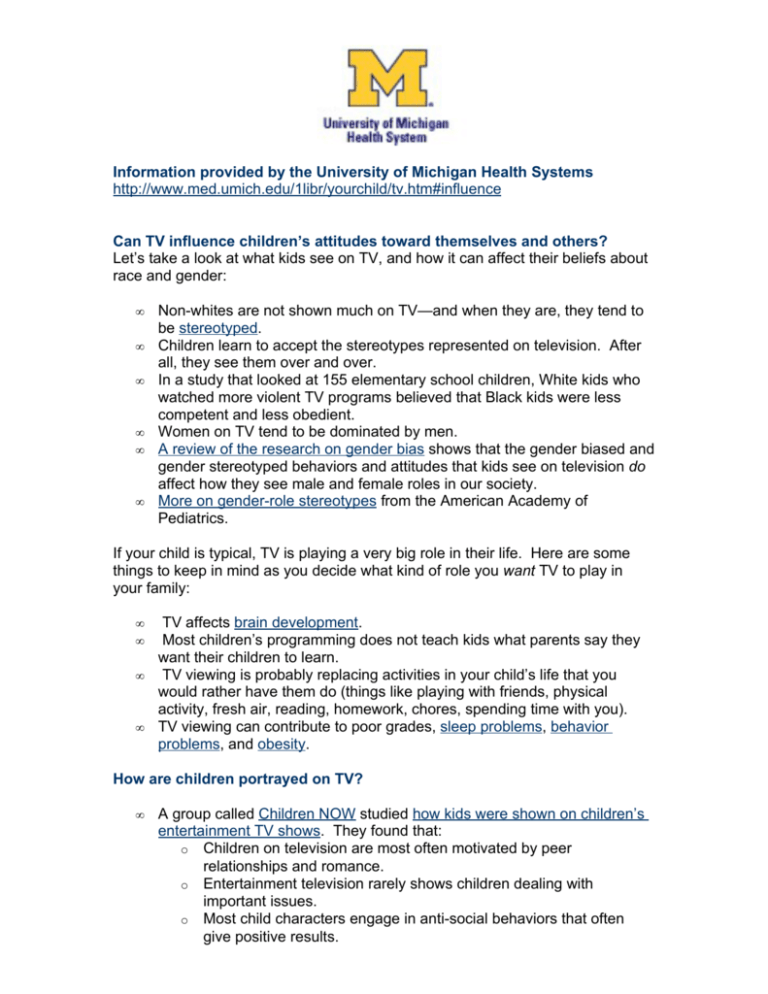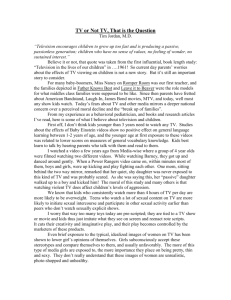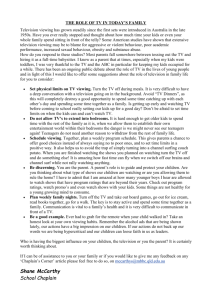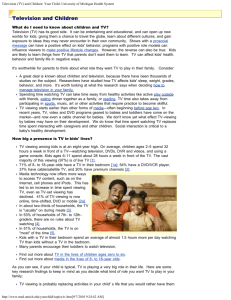Information provided by the University of Michigan Health Systems
advertisement

Information provided by the University of Michigan Health Systems http://www.med.umich.edu/1libr/yourchild/tv.htm#influence Can TV influence children’s attitudes toward themselves and others? Let’s take a look at what kids see on TV, and how it can affect their beliefs about race and gender: • • • • • • Non-whites are not shown much on TV—and when they are, they tend to be stereotyped. Children learn to accept the stereotypes represented on television. After all, they see them over and over. In a study that looked at 155 elementary school children, White kids who watched more violent TV programs believed that Black kids were less competent and less obedient. Women on TV tend to be dominated by men. A review of the research on gender bias shows that the gender biased and gender stereotyped behaviors and attitudes that kids see on television do affect how they see male and female roles in our society. More on gender-role stereotypes from the American Academy of Pediatrics. If your child is typical, TV is playing a very big role in their life. Here are some things to keep in mind as you decide what kind of role you want TV to play in your family: • • • • TV affects brain development. Most children’s programming does not teach kids what parents say they want their children to learn. TV viewing is probably replacing activities in your child’s life that you would rather have them do (things like playing with friends, physical activity, fresh air, reading, homework, chores, spending time with you). TV viewing can contribute to poor grades, sleep problems, behavior problems, and obesity. How are children portrayed on TV? • A group called Children NOW studied how kids were shown on children’s entertainment TV shows. They found that: o Children on television are most often motivated by peer relationships and romance. o Entertainment television rarely shows children dealing with important issues. o Most child characters engage in anti-social behaviors that often give positive results. Children of color are under-represented on television. Girls and boys are almost equally represented but there are important differences in the way in which they are portrayed. A study by the same group of how children are shown on local TV news, found that: o Almost half of all stories about children focus on crime (45%). o Children account for over a quarter of the U.S. population but only 10% of all local news stories. o African American children account for more than half of all stories (61%) involving children of color, followed by Latino children (32%). Asian Pacific American and Native American children are virtually invisible on local news. o African American boys are more likely than any other group to be portrayed as perpetrators of crime and violence whereas Caucasian girls are most likely to be shown as victims. o o • Can TV affect my child’s health? Yes, in several different ways. First of all, kids get lots of information about health from TV, much of it from ads. Ads do not generally give true or balanced information about healthy lifestyles and food choices. The majority of children who watch health related commercials believe what the ads say. Second, watching lots of television can lead to childhood obesity and overweight. Finally, TV promotes risky behavior, such as trying dangerous stunts, substance use and abuse, and irresponsible sexual behavior. Visit these related topics on YourChild: • • • • • Media and Media Literacy Video Games The Internet Obesity Sleep Problems Written and compiled by Kyla Boyse, R.N., Maia McCuiston, M.D., and Ellen Song, M.D. Edited and updated by Kyla Boyse, R.N. Reviewed by Richard Solomon, M.D. U-M Health System Related Sites: U-M Pediatrics











